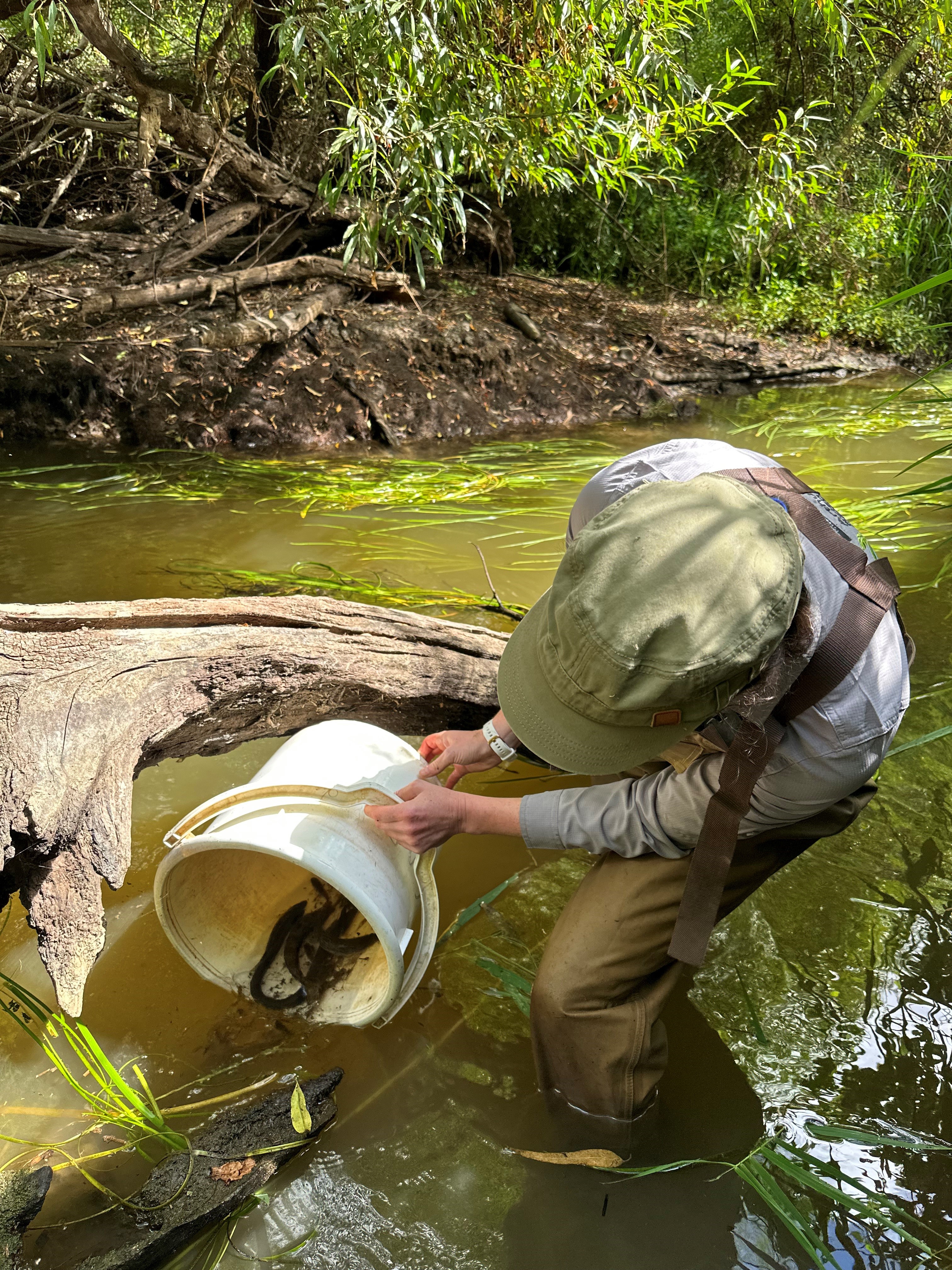Native fish, plants, animals like platypus and rakali (water rats) and waterbugs in the flow-stressed Moorabool River (Moorabool Yulluk) rely on water for the environment to survive, breed and grow in the highly regulated system.
The Moorabool flows south from Victoria’s Central Highlands near Ballarat and joins the Barwon River north of Geelong, connecting it to the internationally recognised Port Phillip Bay (Western Shoreline) and Bellarine Peninsula Ramsar site used by thousands of migratory birds from around the world.
The Moorabool system is in a heavily farmed water supply catchment for Barwon Water and Central Highlands Water, and water available for the environment is limited. The river system is disconnected by intense regulation and its lower section alone has nine private diversion weirs that form barriers to fish.
The Moorabool, Bostock and Lal Lal Reservoirs are the major storages, with water allocated to the Moorabool River Environmental Entitlement 2010 stored in Lal Lal Reservoir. The Moorabool River relies greatly on winter and spring rainfall and environmental water to maintain flows over dry periods.
Use of the water entitlement is limited by inflows to Lal Lal Reservoir and specified conditions that cap deliveries to a maximum of 7,500 megalitres (ML) over three years, or an effective average of 2,500 ML each year for the environment.
Water for the environment is released from Lal Lal Reservoir as a base flow to maintain connectivity immediately downstream of the reservoir and provide fresh water for native plants and animals. It is also released as a fresh event (i.e. a high pulse of water), timed to trigger fish migration and spawning.
The river needs a continuous low flow through the year and periodic freshes to achieve the intended environmental outcomes in the seasonal watering plan. In average and wet years, most of the recommended flow is expected to be provided through a combination of natural flow, passing flow and operational releases. This allows the delivery of additional freshes to improve environmental conditions.
Environmental values
The river sustains life for animals and plant communities like streambank shrubland, grassy woodland, escarpment shrubland, plains grassy woodland, riparian woodland and floodplain riparian woodland. It is a vital corridor for birds, fish and platypus, and one aim of planned environmental watering is to maintain a self-sustaining breeding population of platypus and support dispersal of juveniles and movement of adults.
Native fish that are known to live in the Moorabool catchment include the Australian grayling, river blackfish, Australian smelt, flat-headed gudgeon, southern pygmy perch, short-finned eel, short-headed lamprey, spotted galaxias and tupong.
Moorabool Yulluk has great cultural significance for Wadawurrung Traditional Owners and their Country. Traditional sources of food, materials and medicines include short-finned eel (bunyia), tupong, river blackfish (ware-rap), platypus (wad-dirring/perridak), common reed (tark) and bull rush, and river confluences and deep pools are places for meeting, ceremonies, trade and marking clan boundaries.
Wet conditions boost effects of watering
The Moorabool enjoyed very wet conditions in 2022-23, following two wetter than average years. Lal Lal Reservoir spilled and high natural flows meant no environmental releases were needed in the Moorabool from September to December 2022. There were no major floods, but in one day the fourth highest flow over the past 50 years was recorded in the river.
The high river flows allowed native fish to move past the Moorabool’s many low flow fish barriers and recent monitoring conducted as part of the Victorian Environmental Flows Monitoring Assessment Program (VEFMAP) detected increased abundance and distribution of native fish throughout the river.
- the total number of river blackfish caught was more than double the number caught in 2022 (i.e. 121 vs 55)
- fish ecologists from the Arthur Rylah Institute (ARI) who conducted the VEFMAP surveys caught 1,771 fish from 15 sites in the Moorabool system and noted these improvements to native fish numbers
- river blackfish were caught in a section of the east branch of the Moorabool River for the first time since regular monitoring began three years ago
- nearly twice as many tupong were caught in the lower Moorabool compared to 2022.
The high natural river flows also increased the amount of inundated habitat and improved the quality and quantity of food within the river channel, which would have likely improved the health and condition of native fish
In most years, the environmental watering program’s first priority is to maintain low flows in certain river reaches and to deliver freshes when possible to help native fish, platypus and other animals and plants persist within the Moorabool River.
Because natural flows met many of the minimum environmental flow requirements during 2022, water for the environment was used to increase the magnitude of low flows and freshes during summer and autumn to improve, rather than just maintain, conditions for native fish and platypus.
Delivering low flows closer to the upper end of their recommended range increases opportunities for native fish movement, improves water quality, inundates more woody habitat and fringing riparian vegetation that waterbugs can use, and increases habitat and food for platypus.
All of these outcomes will help to consolidate the environmental benefits of recent wet conditions and increase the resilience of the Moorabool’s distinctive plants and animals to help them cope with the next dry period.
